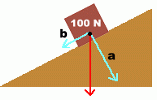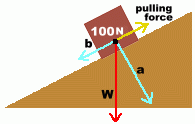 Here is the same object sitting on an inclined plane. Here is the same object sitting on an inclined plane.Inclined planes are often called ramps. The weight of the object is forced to push in two different directions: - into the ramp (a) - back down the ramp (b) The part of the weight that pushes into the ramp (a) will cause friction to increase, and make you have to work a little harder. The effect is usually small, so we'll ignore that here, and pretend that the ramp is frictionless. The part of the weight that pushes back down the ramp (b) is the force you will have to overcome in order to pull the object up the ramp. Because the ramp has split the weight into forces moving in different directions, each force is smaller than the original weight. In particular, force (b) is less than the full weight of the object.  The pulling force you must supply to make the object move up the ramp needs to be the same size as force (b), but in the opposite direction. Force (b) is less than the weight of the object, so pulling it up the ramp requires less force than lifting it.
The pulling force you must supply to make the object move up the ramp needs to be the same size as force (b), but in the opposite direction. Force (b) is less than the weight of the object, so pulling it up the ramp requires less force than lifting it.The shallower the ramp, the less hard you have to pull to get the object to rise. The tradeoff is that you must move the object farther to lift it to the same height. If you don't want to pull very hard to get it up the ramp, you'll need to pull it a much longer distance.  Lifting the mass straight up (case 1) through vertical distance d requires the largest force. Pulling it up ramp 2 through vertical distance d requires less force, but you have to move it farther. Pulling it up ramp 3 through vertical distance d requires the least force of all, but you have to move it much farther. In all cases, however, the total amount of work you do is the same, since the smaller forces are balanced with larger distances. Work = Force x Distance remains constant. NOTE FOR PHYSICS STUDENTS: We are conveniently ignoring the fact that if you pull with a force exactly equal to the weight of the object, the object will be suspended, but won't move upwards. In fact, as you know, an additional small force must also be applied to accelerate the object upwards. This additional force is also lessened in the same proportion by the use of an inclined plane. It has been ignored here for the purpose of clarity. |
